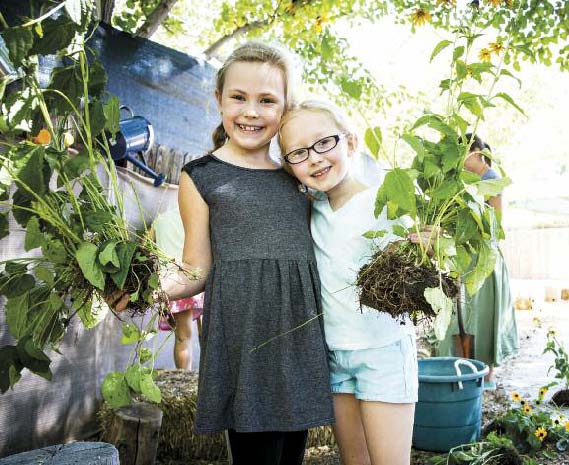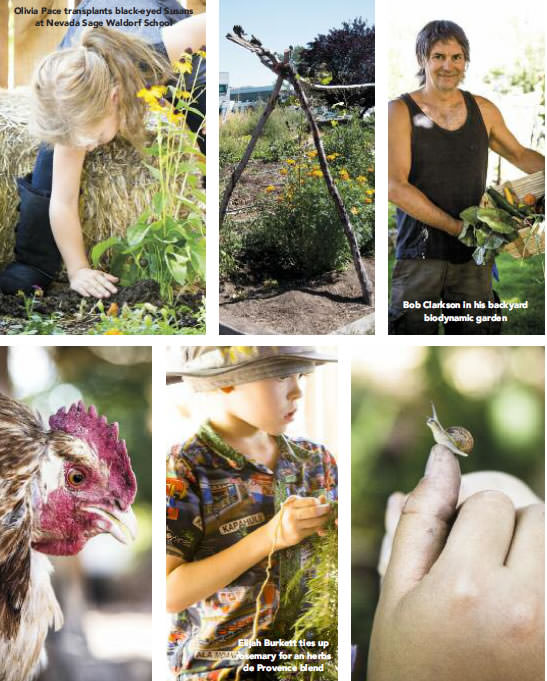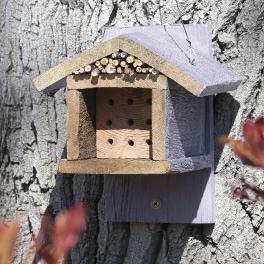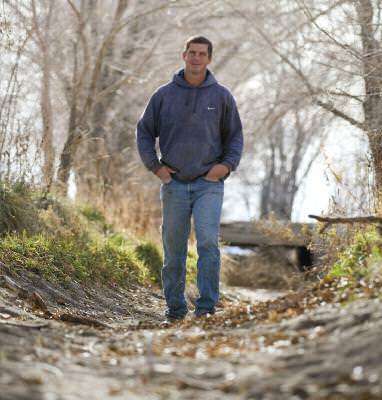edible garden
BUILD A BEE HOUSE
Help area pollinators with this inexpensive solution.
WRITTEN BY CHRISTINA NELLEMANN
PHOTOS BY KEVIN KARL
“We have such a great diversity of pollinators in the Great Basin area,” says Joy Paterson, Lyon County extension educator, University of Nevada Cooperative Extension. “It’s nice if you can create an oasis habitat that gives them all they need to thrive.”
Creating homes for these beneficial insects might be one of the easiest (and most fun) things you can do in your own garden. Paterson keeps it simple by cutting leftover hollyhock stems that are 6 to 12 inches long into bundles and placing them in the forks of her fruit trees.
If you want to get a little fancier, you can copy the mason bee house design provided here by Kevin Karl, a freelance designer and photographer who also works part time with the cooperative extension as a community-based instructor.
“This is just one of the little things that anyone can do to support habitats and ecosystems,” Karl says. “I purchased nothing to make this bee house. My only investment was time and good intentions.”
Mason bee house
Karl used scrap lumber for his house, but if you do need to purchase anything, avoid using treated wood.
1. Cut a four-by-four piece of lumber into a five-inch length. A minimum of five inches is necessary to accommodate the three to five eggs laid by the female mason bee.
2. Using a pegboard as a template, mark the open spaces with a pencil and drill 5/16-inch diameter holes all the way through the wood. This makes it easier to clean out the holes (with a dowel or straight stick) when the bees have left the house.

3. Use one-by-six cedar fencing and build a small box to hold the four-by-four piece in place; add a back support and a gable roof. The four-by-four nest section can slide out of the box to be cleaned when necessary.

4. Karl’s house includes a front porch flight board, where insects can land, and a few branches in the gable act as a space for other bees and insects. A screen over the front area is recommended to keep parasitic insects from preying on bee larvae.

5. Karl attached the house to a tree in his front yard, where it can get early morning sun and be protected from harsh winds.
Insect-friendly gardens
To attract more insects to your new abode, lure them in with their favorite flowers, plus a little area with some water and mud, which the bees pack into the holes of a bee house.
John Strickland, owner of Washoe Zephyr Gardens in Washoe Valley, has been cultivating his insect-friendly garden for several years. His recommendations for plants that attract pollinators include some old favorites and some unusual varieties.
“We see insects on our penstemon, coneflower, catmint, and heliopsis,” Strickland says. “When the moon carrot blooms, every wasp, fly, and bee is on it.”
Other blooming plants in Washoe Zephyr Gardens include honeysuckle, yellow buckwheat, tansy, yarrow, and salvia.
Both Karl and Strickland have photographed the area’s various pollinators. The larger-than-life images capture monarch butterflies, bald-faced hornets, and fuzzy long-horned bees.
“When people start looking around,” Paterson says, “they will discover these creatures are right under their noses.”
Christina Nellemann is a writer living in Washoe Valley. Inspired by the Galena bee hotel (see story sidebar, below), she will be working on a few of her own insect houses this fall.
Resources
Pollinator haven
Check in to Nevada’s insect hotel.
To see the Hilton of bee houses, visit the pesticide-free bee pollinator garden at the Galena Creek Visitor Center in south Reno. Built by Elrick du Saillant du Luc, a graduate student from Aix-Marseille University in France, with support from Sandy Rowley of http://www.Beehabitat.com and the Reno/Sparks Association of Realtors, the hotel consists of several separate compartments filled with natural materials that attract beneficial wild pollinators.
One room filled with clay mixed with straw and hollow stems attracts solitary bees. Ladybugs flock to the room with closely spaced boards. Butterflies are attracted to straw, herbs, and honey flowers. And earwigs delight in the upturned clay pots filled with straw. The entire structure faces south to capture winter sun, and its back faces north to keep in the heat.
According to Gwen Bourne, associate director of the Great Basin Institute and director of the Galena Creek Visitor Center, the bee hotel has received a tremendous response from visitors to the park.
“People are really interested and will stop and take a good look at it,” Bourne says. “Some people have created their own — albeit smaller — hotels in their own backyards.”
For details, visit http://www.Galenacreekvisitorcenter.org
Catch a buzz
Buy local, ready-made bee houses.
If you want to support a local business, The Best Brushes in Yerington sells several bee houses and condominiums, including a “Do It Yourself” Insect Hotel Kit ($49.50). The abode attracts several different types of insects and the kit comes complete with everything you or your child needs to construct a house, including the hammer, nails, and glue.
For details, visit http://www.Thebestbrushes.com


